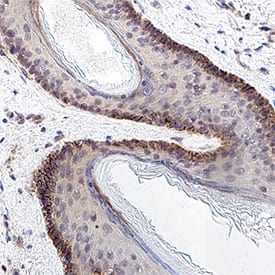Human/Mouse Cadherin-13 Antibody Summary
Glu23-Ala692
Accession # P55290
*Small pack size (-SP) is supplied either lyophilized or as a 0.2 µm filtered solution in PBS.
Applications
Please Note: Optimal dilutions should be determined by each laboratory for each application. General Protocols are available in the Technical Information section on our website.
Scientific Data
 View Larger
View Larger
Detection of Cadherin‑13 in Human Skin. Cadherin‑13 was detected in immersion fixed paraffin-embedded sections of human skin using Rat Anti-Human/Mouse Cadherin‑13 Monoclonal Antibody (Catalog # MAB3264) at 5 µg/ml for 1 hour at room temperature followed by incubation with the HRP-conjugated Anti-Rat IgG Secondary Antibody (Catalog # HAF005) or the Anti-Rat IgG VisUCyte™ HRP Polymer Antibody (Catalog # VC005). Before incubation with the primary antibody, tissue was subjected to heat-induced epitope retrieval using VisUCyte Antigen Retrieval Reagent-Basic (Catalog # VCTS021). Tissue was stained using DAB (brown) and counterstained with hematoxylin (blue). Specific staining was localized to the membrane. View our protocol for Chromogenic IHC Staining of Paraffin-embedded Tissue Sections.
Reconstitution Calculator
Preparation and Storage
- 12 months from date of receipt, -20 to -70 °C as supplied.
- 1 month, 2 to 8 °C under sterile conditions after reconstitution.
- 6 months, -20 to -70 °C under sterile conditions after reconstitution.
Background: Cadherin-13
Cadherin-13, also known as T-cadherin and H-cadherin, is a 105 kDa member of the cadherin family of transmembrane glycoproteins that mediate calcium-dependent intercellular adhesion (1). However, Cadherin-13 is an atypical member, lacking transmembrane and cytosolic domains and containing a GPI moiety that anchors Cadherin-13 to the plasma membrane (1‑2). Human Cadherin-13 is synthesized as a 713 amino acid (aa) precursor that contains a 22 aa signal sequence, a 116 aa propeptide, a 555 aa mature chain, and a second propeptide of 20 aa that is removed in the mature form to reveal the GPI anchor. The mature form contains five cadherin domains and eight potential sites for N-linked glycosylation. Mature human Cadherin-13 shares 96% aa identity with mature mouse Cadherin-13. Cadherin-13 is expressed in various tissues. It is highly expressed in the heart, and in the CNS, Cadherin-13 is expressed in the cerebral cortex, medulla, hippocampus, amygdala, thalamus, and substantia nigra (2). There are higher levels of Cadherin-13 in the adult brain than in developing brain (2). Cadherin-13 is also expressed in skin in the basal layer of the epidermis, lung, liver, kidney, and blood vessels (2). The structural characteristics of Cadherin-13 predict that it is unlikely to function as a true adhesion molecule in vivo (2). It is suggested that it may act rather as a signaling receptor participating in recognition of the environment and regulation of cell motility, proliferation, and phenotype (2). Cellular expression levels of Cadherin-13 in various tissues often correlate, negatively or positively, with the proliferative potential of the cells (2). Cadherin-13 may also act as a suppressor of tumor cell growth (2). This potential role for Cadherin-13 was emphasized by localization of Cadherin-13 gene to chromosome 16q24, a region exhibiting loss of heterozygosity in many solid tumors (2). Allelic loss of chromosome bands 16q24.1-q24.2 and reduced expression of Cadherin-13, as well as hypermethylation of the remaining allele have been detected in a considerable number of human cancers (2).
- Tanihara, H. et al. (1994) Cell Adhes. Commun. 2:15.
- Philippova, M. et al. (2009) Cell. Signal. 21:1035.
Product Datasheets
Citations for Human/Mouse Cadherin-13 Antibody
R&D Systems personnel manually curate a database that contains references using R&D Systems products. The data collected includes not only links to publications in PubMed, but also provides information about sample types, species, and experimental conditions.
3
Citations: Showing 1 - 3
Filter your results:
Filter by:
-
A human adipose tissue cell-type transcriptome atlas
Authors: M Norreen-Th, EC Struck, S Öling, M Zwahlen, K Von Feilit, J Odeberg, C Lindskog, F Pontén, M Uhlén, PJ Dusart, LM Butler
Cell Reports, 2022-07-12;40(2):111046.
Species: Human
Sample Types: Whole Tissue
Applications: IHC -
Adiponectin accumulation in the retinal vascular endothelium and its possible role in preventing early diabetic microvascular damage
Authors: TA Sakaue, Y Fujishima, Y Fukushima, Y Tsugawa-Sh, S Fukuda, S Kita, H Nishizawa, B Ranscht, K Nishida, N Maeda, I Shimomura
Scientific Reports, 2022-03-09;12(1):4159.
Species: Mouse
Sample Types: Cell Lysates
Applications: Western Blot -
Positive feedback regulation between adiponectin and T-cadherin impacts adiponectin levels in tissue and plasma of male mice.
Authors: Matsuda, Keisuke, Fujishima, Yuya, Maeda, Norikazu, Mori, Takuya, Hirata, Ayumu, Sekimoto, Ryohei, Tsushima, Yu, Masuda, Shigeki, Yamaoka, Masaya, Inoue, Kana, Nishizawa, Hitoshi, Kita, Shunbun, Ranscht, Barbara, Funahashi, Tohru, Shimomura, Iichiro
Endocrinology, 2014-12-16;156(3):934-46.
Species: Mouse
Sample Types: Tissue Homogenates, Whole Tissue
Applications: IHC, Western Blot
FAQs
No product specific FAQs exist for this product, however you may
View all Antibody FAQsReviews for Human/Mouse Cadherin-13 Antibody
There are currently no reviews for this product. Be the first to review Human/Mouse Cadherin-13 Antibody and earn rewards!
Have you used Human/Mouse Cadherin-13 Antibody?
Submit a review and receive an Amazon gift card.
$25/€18/£15/$25CAN/¥75 Yuan/¥2500 Yen for a review with an image
$10/€7/£6/$10 CAD/¥70 Yuan/¥1110 Yen for a review without an image
